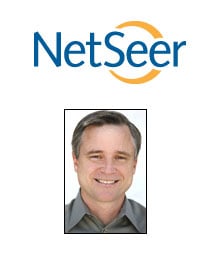 John Mracek is CEO of NetSeer, a contextual ad technology company whose products include media buying services and a contextual links ad network. NetSeer has had $14.4 million in investment to date from Mission Ventures and Onset Ventures.
John Mracek is CEO of NetSeer, a contextual ad technology company whose products include media buying services and a contextual links ad network. NetSeer has had $14.4 million in investment to date from Mission Ventures and Onset Ventures.
How has the company’s overall strategic plan evolved since last we spoke in December of 2009?
JM: Since we last talked, we were in the process of building out what we now call our ConceptLinks business, which is a monetization unit for publishers that turns display into search. And we launched that successfully last year and have been building that business. At the beginning of this year, we launched our media business, which is all about using our contextual technology in order to find brand-safe and contextually relevant media on the various exchanges.
We went from zero to three salespeople in the past couple of months and are really building out that media business.
Should we expect to hear announcements from NetSeer regarding integration of your technology into exchanges that are out there right now, similar to the deals that are done by semantic and contextual tech providers who are integrated into AppNexus and the sell‑side‑platform players?
We do have several licensees of our data, but our primary focus on the exchange is not as a data provider. We use our technology ourselves in order to actually extract the media ourselves. So we sit on the exchanges and have our own seat. We look at like 50 billion impressions a month. So we use our own data to capture our own media on behalf of advertisers.
Our primary business there is the media. But, we do have licensees like Cox Digital Systems, formerly Adify. Martini Media also uses our technology. But, we strongly believe that the best application of our technology is in our own media sales.
From a buyer’s perspective, what are the attributes of buying through NetSeer? Why would they want to buy through NetSeer?
So today, we have quite a few advertisers already across credit cards, cable providers, health, et cetera. What our value proposition is is that we provide a way to get premium inventory in an economic way.
There’s a dichotomy right now. A buyer can get quality inventory by going to direct sites, buying endemic sites. Or the buyer can go to the exchange and do cookie hunting, audience targeting‑‑which has, obviously, its merits, and we do that as well.
But the rest of the exchange, how does the buyer know what they are really getting?
Our point is, look, if you’ve got a contextual match, you’re going to get good performance.
In terms of ad verification and those types of services ‑‑ AdSafe, DoubleVerify, Adometry and so on, does your media buying offering replace the need for services like those?
We present that you don’t need them by definition of how our product works. However, we work cooperatively with them as well, because some clients mandate to their agencies, or the agencies mandate that they want those overlays.
So we work in either mode, but we say, “Hey, you can save your money and not use it,” but it’s totally up to the agency.
We’ve seen in some of our campaigns that the client comes back and sends a broad notice to all their media suppliers saying, “We’ve found these in such and such domains being purchased, please cease and desist.” And we’re able to go back and say, “In our list, these guys were deemed non‑brand‑safe, so we never bought them in the first place.” So it actually works pretty well for us, because we look well when clients do those audits.
Isn’t NetSeer another case which shows that the ad network model continues to thrive. It’s not dead in spite of what many may say. Effectively, you’re providing ad network services, correct?
No.
I think why people are saying that is because in the old model the ad network has a fixed set of inventory that it has to move. The interests are not necessarily aligned with the advertiser. So you’re trying to optimize based on the inventory that you have and trying to find the right match with the advertiser and a lot of times it works and sometimes it doesn’t.
In the new world, and the way we look at ourselves, we don’t have to make that choice. We don’t have to find a place or give an impression. We have this discussion a lot with agencies because they have negative perceptions of ad networks.
We say, our best answer is, “We’re not really a network, we’re a media supplier.” But you could also say we’re a next generation network. It’s a network whose inventory is completely elective and based on the objectives of the advertiser.
Are you exposing your margins yet?
No, we basically give them a price. Our model is CPM and ultimately it’s got to perform for them or it doesn’t, and so that’s the ultimate metric.
Are you surprised by what appears to be momentum in the data‑driven, digital advertising business, particularly around media buying and display?
I’m not surprised at all. In fact, I was in online advertising at a company called Focalink in ’96, where we had what would then be called the equivalent of a DSP. There were no exchanges, but the notion was buy‑side ad serving and media management. And a lot of the techniques that are being used now were thought of then or pioneered then, but it was way too early. There wasn’t the enabling infrastructure. And now we’re at a point where you have many more sources of data and a more liquid data market. I think one of the biggest enablers in all of this is, and frankly, where our company is focused, is the advent of exchanges.
Let me ask you about attribution. Is still last‑click the most important thing out there?
I’m seeing more of the advertisers and agencies get more sophisticated in how they view that. Some of our agencies, they’re running search, they’re running our contextual, retargeting, and they basically look at that whole funnel of activities. Everybody’s got their own tweak on it ‑ but they have some fundamental algorithm or methodology they use to get attribution across all the media types so they don’t overly skew it to last click.
How far away do you think it is when NetSeer will be able offer some sort of engagement pricing?
We don’t have an explicit plan for engagement pricing. I think the way clients are evaluating us, they all do it differently. They, in effect, are evaluating us on engagement because they’re saying, “I’m looking at clickthroughs, viewthroughs, page metrics, time spent on a site, number of page views, etc.” and they combine that into one large metric, which you could argue is an engagement metric.
I could see in certain cases that potentially it evolves to a particular engagement metric which is the sum of many sub‑pieces. But, I can’t think of a specific case where we would be doing that anytime soon.
And what about moving beyond the PC‑based display ad? Any thoughts about moving into other channels? I’m particularly curious about how video might be applicable.
We have initiatives around both mobile and video. We are starting to see a lot of interest in mobile, and a lot of the agencies are, when they’re thinking of their campaigns, want all three components. So we’re bullish on mobile and video, but in terms of the liquidity of that inventory in an exchange ‑ relative to standard display ‑ it’s a little bit early in the evolution there.
What are a few of the milestones that you would like the company to have accomplished a year from now?
I can’t divulge actual numbers, but we’re on a very nice trajectory on our media business. Seeing us just continuing that growth rate and having a very high run rate on our media business. On our ConceptLink business, I think you’ll see us, even in the not‑too‑distant future, having our ad units appear on some very prominent sites.
Basically, you will see a company that has a very large stable of top advertisers buying media and then top publishers using our concept and products.
By John Ebbert













